Problems integrating Contemporary Art into Ritual Spaces
David Rastas
Ritual architecture presents a series of problems for the artist and curator that may not be encountered in the museum or other types of historical space. Ritual spaces are anchored in political, cultural and social traditions that integrate multiple narratives of place, self and history. The encounter of contemporary art in ritual space brings together a self-reflexive aesthetic experience with an enraptured contemplation aimed at spiritual transcendence. All objects encountered in ritual space are transformed by a ritual significance which compel attentiveness and demand a response. By virtue of an artwork’s presence within the context of ritual, it becomes vested with symbolic meaning connected with past experiences, memories and religious narratives. This paper examines the mechanics of site-specificity and site-responsive art in historical spaces infused with cultural meaning and activated by ritual, through a series of installations in monumental church buildings. These installations have attempted to address the formal, conceptual, and contextual implications of encountering art in an ideologically-loaded, historical space. Each of the installations discussed have sought to enter into a meaningful dialogue with the historical, social and ritual significance of the space.
The conditions which have allowed interventions of contemporary art in historic churches result from the radical changes to ritual function during the twentieth century, particularly the stripping of ritual significance from subsidiary altars and chapels. Since 1970, there have been hundreds of installations of contemporary art in churches, synagogues, mosques, temples and other forms of ritual space. Curatorial approaches to installing contemporary art in historic ritual spaces have developed from site-specific and site-responsive practice, ahistorical methods of display in museums, and institutional critique. In 1986, Friedhelm Mennekes began a twenty-five year program of installations of contemporary art in the seventeenth century church of St Peter in Cologne. The Sankt-Peter Kunst-Station set the benchmark for interventions in churches and Mennekes’ strategy for incorporating non-religious contemporary art into active ritual space has had a major influence on similar projects across Europe. There are several organisations based in the UK that work with art in churches including CGP Dilston Grove, Art in Sacred Spaces, Florence Trust and Art Angel. Historic churches that have a long program of installing contemporary art include Chapelle Saint-Louis de la Salpetrière in Paris, San Fedele in Milan, Sankt Andrä Kunstkirche in Graz, San Giorgio Maggiore in Venice, and L'art dans les chapelles based in France. The series of exhibitions by KUNSTGLAUBE in Vienna sought to position each artwork within a conceptual organisation around determined themes to support discursive dialogue between specific spaces and works.
.jpg)
Rosemarie Trockel
Ich habe Angst
Sankt Peter Kunst Station, Cologne, 1993
Photo: Wilfried Dickoff
The reorientation of recent art practice toward site-specificity has its origins in a rejection of the assertion that an artwork is self-sufficient and self-contained. The progressive relinquishment of the principle of aesthetic autonomy and its sustained interrogation underpin developments in site-specific practice. An emphasis on the autonomy of art limited the expression of empirical subjectivity and promoted universality as a core element, aided by the setting apart of art from the world of consumable things and the breaking down of interrelationships between the artwork and its social context. In early discussions on site-specific art, Miwon Kwon defined the ‘site’ according to phenomenological, institutional, and discursive paradigms.1 The first paradigm defined the site as an actual physical location, the second as informed by the dynamics, politics and power structures of the institution, while the third paradigm was characterised by a ‘discourse’ or field of knowledge.2 Each of these paradigms can be applied to an analysis of site-specificity in ritual space. The phenomenological paradigm already relates to the installation of contemporary art in a variety of sites outside the museum, including ritual spaces. Extending the institutional paradigm beyond the museum and gallery to also refer to the religious institution, implicates the politics and power structures in ritual space. The dematerialised site defined by the discursive paradigm, involving theoretical concepts and the social realm, could refer to the liturgical, theological and social issues associated with ritual space. In addition to the three paradigms, I propose an additional paradigm to describe the mysterious enactment of sacramental rites and transcendental character of ritual space. This fourth paradigm defines the site as an ‘affective’ space which evokes sensations of pleasure, awe, fascination, terror, disgust, consolation, transcendence and surprise. It could be referred to as either the ‘affective’ or ‘sacramental’ paradigm. In ritual space, the unique function of aesthetic objects is established through the contemplative mode adopted in private devotional practice. Artworks are absorbed into the realm of visual piety as vehicles for transcendent experience and the focus of meditative reflection. The distinct types of response to an artwork in ritual space were traditionally either liturgically structured or shaped by devotional practice. An overlapping of the phenomenological, institutional, discursive and sacramental paradigms featured in the site-oriented installation of Clemens Wilhelm’s ‘JE CROIS QUE JE SUIS MALADE (I Believe I Am Sick)’ in a confessional in the Votive Church in Vienna. The video artwork was included in the Leiblichkeit und Sexualität (Corporeality and Sexuality) exhibition in the neo-Gothic church in 2014. The work consisted of a vertical screen standing in the position where the priest normally sits during the administration of the sacrament of penance (hearing confessions). Wilhelm’s silent video was filmed in the former residence of French playwright Jean-Baptist Poquelin (Molière), where he died in 1673. In producing the work, the artist invited people into a small room in Molière‘s home, where they were asked to take a seat and recite the sentence “I believe I am sick” into the camera. Even before the work entered the church, its content was attached to the physical reality of the playwright’s apartment as its initial phenomenological site. The confessional is an enclosed wooden box divided by two screens. Low benches give the penitent the opportunity to kneel and make their verbal confession to the priest through the screen. Wilhelm’s installation provided seats directly opposite the confessional for the viewer to sit in imitation of the speakers in the video. The words “I believe I am sick” in French, German and English scrolled across an LED display placed below the video screen. Because the film was silent, viewing the work prompted a focus on body language and facial expressions. The phenomenological paradigm relates to the physical structure of the confessional, drawing attention to the ritual act accommodated by the space. Through taking a seat in front of the video installation and reading the words, the visitor participated in an extension of the confessional ritual. The act of speaking the words “I believe I am sick” could then be considered in relation to the words spoken in the penitential rite, “I have sinned.” The phenomenological experience of the site prompted visitors to engage in ritual. The institutional paradigm bought into focus the potential for the intervention to critique the power structures of the religious institution. Considering the video screen occupied the space for the priest, some visitors felt that the work suggested that the priest is sick. This particular interpretation was reinforced by having encountered previous works in the exhibition that had addressed the sexual abuse scandal in the Catholic Church. The intervention also made the confessional space inaccessible for administering the penitential rite, which also contributed to a form of institutional critique. In Foucault’s The History of Sexuality, he outlined the central role of confession in the order of civil and religious powers as an “institutional incitement to speak.”3 The positioning of Wilhelm’s work denied this institutional incitement through its appropriation of the space. The words featured in the video were taken from Molière’s last performance of the Imaginary Invalid which included themes of hypochondria, health mania, belief in doctors, and the public display of illness and ego. The discursive paradigm related the “theological” encounter of participation in an extension of the ritual of confession. The discursive site was framed by the abstract theological implications of reconciliation. The codified physical actions prescribed by ritual are corporal in their means and abstract in their agency.4 The sacramental paradigm relates to the potential for Wilhelm’s intervention to facilitate transcendent experience. Individuals resistant to affording ritual space with any ‘intrinsic supernatural ontological status’ might be inclined to consider the work of art and the ritual space as mutually exclusive.5 According to Lindsay Jones, a suspension of disbelief is not only requisite to transacting meaning from ritual space but a precondition for the sacramental encounter.6 The individual need not adhere to the codified prescriptions for specific gestures and responses to ritual space nor have an explicit understanding of subtleties in their structure. The potential for the site of Wilhelm’s video installation to arouse an emotional response in the viewer is dependent on their will to engage, not necessarily on their familiarity with the ritual of penance.
,_2009,_Leiblichkeit_&_Sexualitat,_2014-1.jpg)
Clemens Wilhelm
JE CROIS QUE JE SUIS MALADE (I Believe I Am Sick)
Leiblichkeit und Sexualität
Votive Church, Vienna, 2014
Photo: Christoph Bartylla 2014
One precedent for the installation of contemporary art in historic ritual spaces was the practice of arranging ahistorical juxtapositions of contemporary art within the permanent collection of a museum. The shift in museological practice toward revisiting the cabinet of curiosities, reframing artworks and ahistorical juxtapositions began with the institutional critique of the 1960s and 1970s, which drew attention to the politics of collections and museums. Dialogue between medieval religious objects and contemporary art in the Kolumba Museum in Cologne transform the museum space into a genuine Gesamtkunstwerk. The museum’s annual repositioning of contemporary art with works from different ages demonstrates the “infinite possibilities of aesthetic perception that the same object offers when presented under different circumstances.”7 Another example of the recent approach to ahistorical juxtaposition is in the Museum of Old and New Art in Hobart, Tasmania. The staging of juxtapositions of older objects with contemporary art at MONA is influenced by recent developments in the critique of a museum’s historicist assumptions and institutional authority. The ahistorical juxtaposition of Takashi Murakami’s ‘Figure Miss Ko2’ with a nineteenth century copy of Herkules Farnese in the Votive Church, set a dynamic tension between old and new that was echoed by the pair of sculptures’ relationship to historic ritual space. Murakami’s sculpture is representative of his broader practice, exploring the formal connections between old and new in terms of stylisation, pictorial flatness and all-over composition. His sexualised representation of a female manga character stood in stark contrast to the classical marble sculpture of Herkules. The collisions that occur at the intersection between the old and new forge a hybrid space which becomes the focus of the viewer’s visual attention. Meaning is then located in this hybrid space between the two works.
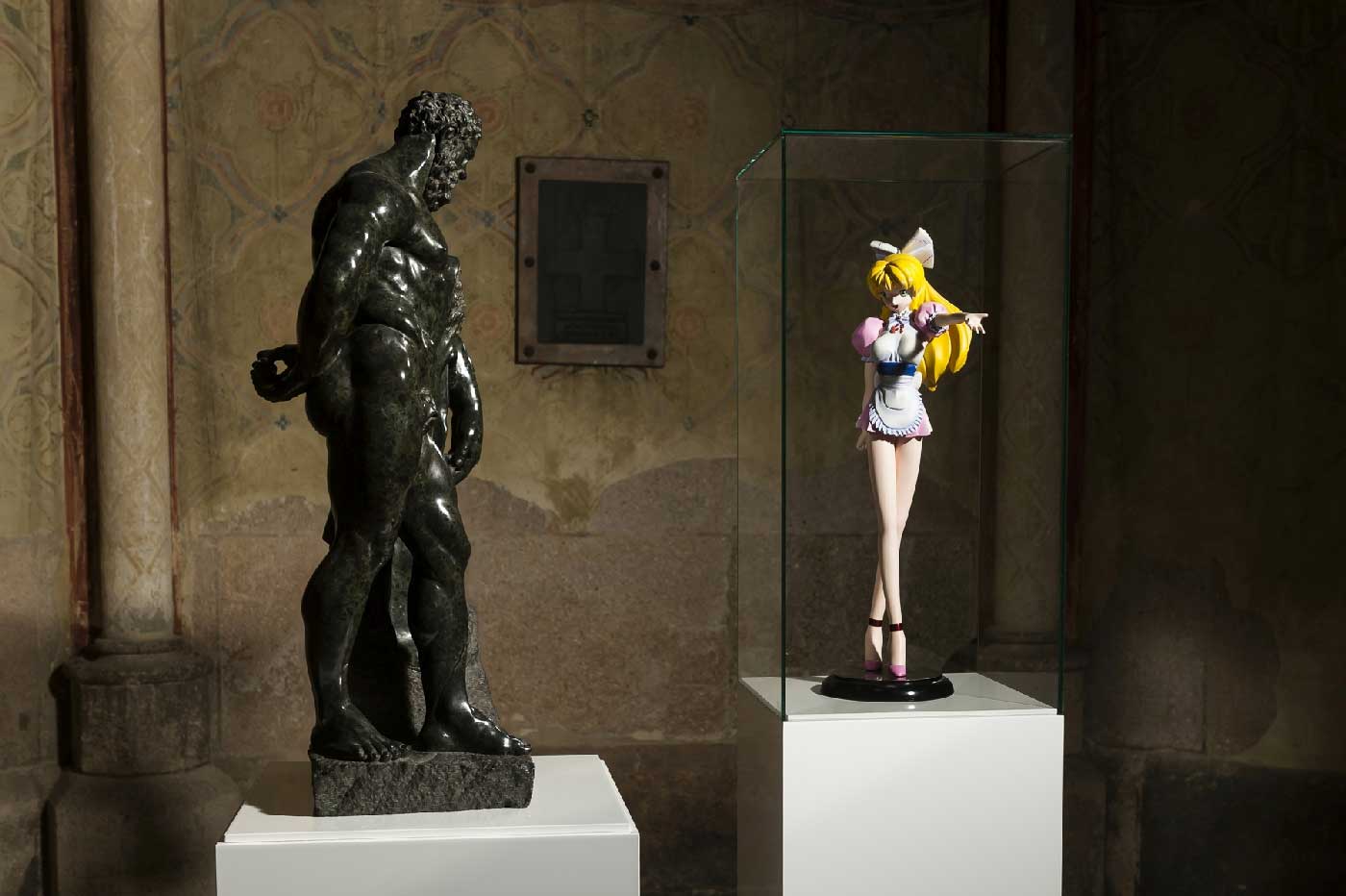
Takashi Murakami
Figure Miss Ko2
Leiblichkeit und Sexualität
Votive Church, Vienna, 2014
Photo: Christoph Bartylla 2014
Some of the precursors for recent ahistorical methods of display include Harald Szeeman’s 1988 exhibition ‘A-Historische Klanken = a-historical soundings’ at the Museum Boymans-van Beuningen in Rotterdam, Rudi Fuch’s documenta 7 in 1982 and the 1984 “Primitivism” exhibition at the New York Museum of Modern Art. In the MOMA exhibition, objects were removed from their original cultural contexts in order to emphasise their formal aspects. Tribal objects were positioned next to canonical European works in a manner that seemed to promote a modernist ideology of universal formal beauty. In most installations of contemporary art in churches, synagogues, mosques and temples since 1970, the emphasis has been on prioritising form in the relationship between the physical attributes of the artwork and site. This has been particularly evident in a series of installations in disused chapels across Brittany, organised by L'art dans les chapelles. An example of a work which emphasises a formal relationship with the spatial volume of the site is Élodie Boutry’s 2014 installation in the Chapelle Saint-Tugdual in Quistinic, France. Her abstract geometric sculpture dominated the space, unwrapping in the chapel like folded origami. Chapels and churches which are still in use could not allow such an invasion into their ritual space. In active churches, the artwork can interfere with the liturgy in very distracting ways. For example, the installation of Bill Viola’s Tristan’s Fire in All Saints Church in Melbourne, prevented liturgies from being celebrated altogether, as the projection screen for the video artwork blocked the entire sanctuary. Such an intrusion into the space would not be a problem if the work were installed in a decommissioned church like the Former Clare College Mission Church (Dilston Grove) in London, or any of the churches annexed for national pavilions during the Venice Biennale. In fact, the possibilities for interventions are virtually unlimited in a space which only contains the remnants of ritual. The complete transformation of Dilston Grove with Michael Cross’ ‘Bridge’ installation involving a large tank of water that visitors could walk across would not be possible to realise in an active ritual space. Likewise, Heather Ackroyd and Dan Harvey’s 2003 grass installation ‘Growth’ in the same space, took full advantage of the absence of ritual. Ackroyd and Harvey applied clay and grass seed to the concrete walls of the derelict church which transformed the space into a “green chamber of living grass.” Ahistorical juxtapositions of contemporary art in derelict spaces have the potential to reactivate the church’s ritual character.
.jpg)
Michael Cross
Bridge
Dilston Grove, London, 2006
Ritual focus increasingly tightened around the sanctuary over the second millennium to prioritise community-oriented ritual. Changes to ritual space following the second Vatican council consolidated this development and almost completely stripped the ritual significance away from subsidiary spaces outside the sanctuary and main body of the church. In efforts to be more inclusive and involve the community, the religious institution sanctioned the reordering of ritual space to involve more active participation in the primary ritual. The fostering of participation as a design priority has influenced the construction of new ritual architecture and had a significant impact on the function of historical spaces. One of the most fundamental changes to ritual space over the course of the twentieth century, was the abandoning of spaces for private contemplation in favour of community oriented ritual.8 Though a sense of sacrality was largely derived from an association with public ritual, an experience of the sacred could be independent of the liturgy. Devotional zones within the church, had previously served to unite the personal experience of religion with the architecture of ritual. These niches, chapels and side altars were both enabled and supported by an aesthetic of silence and contemplation. As these private zones of contemplation lost their function, remaining empty and under-utilised, they set the conditions for interventions of contemporary art. Evidence of the diminishing importance of devotional spaces preceding Vatican II could be seen in the empty ambulatory chapels of the Votive Church in Vienna. The nineteenth century historicist architecture of the Votive Church represents a fusion of diverse historical influences, though its spatial structure was modelled on the architecture of twelfth century Gothic Cathedrals in France.
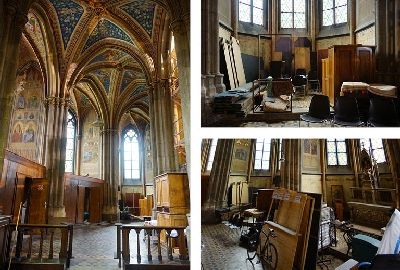
Votive Church Ambulatory 2013
Completed in 1879, the seven radiating chapels surrounding the main sanctuary were never opened to the public. Remaining empty except for a Marian altar in the central chapel, the spaces were eventually used for storage. Regular concerts were held in the Church which prompted the conversion of two chapels into dressing rooms with toilet and wash basin in the 1980s. When preparing the proposal for the Leiblichkeit und Sexualität exhibition, a plan was outlined for cleaning up the ambulatory chapels for the installation of contemporary artworks. One chapel was left as it was found, containing ladders, candles, light fittings, chairs, mattresses and a bronze head of Christ that had been stolen from the church, then returned in a gym bag. A site-responsive intervention of Hermann Glettler’s ‘Cleaning You’ was placed on a shelf among the found objects. The video on a small vintage television screen featured the artist approaching a gothic carving of Christ’s crucified body as it lay on the floor of a French church. He knelt down and proceeded to clean the entire sculpture with his tongue - licking away the dust of several hundred years.
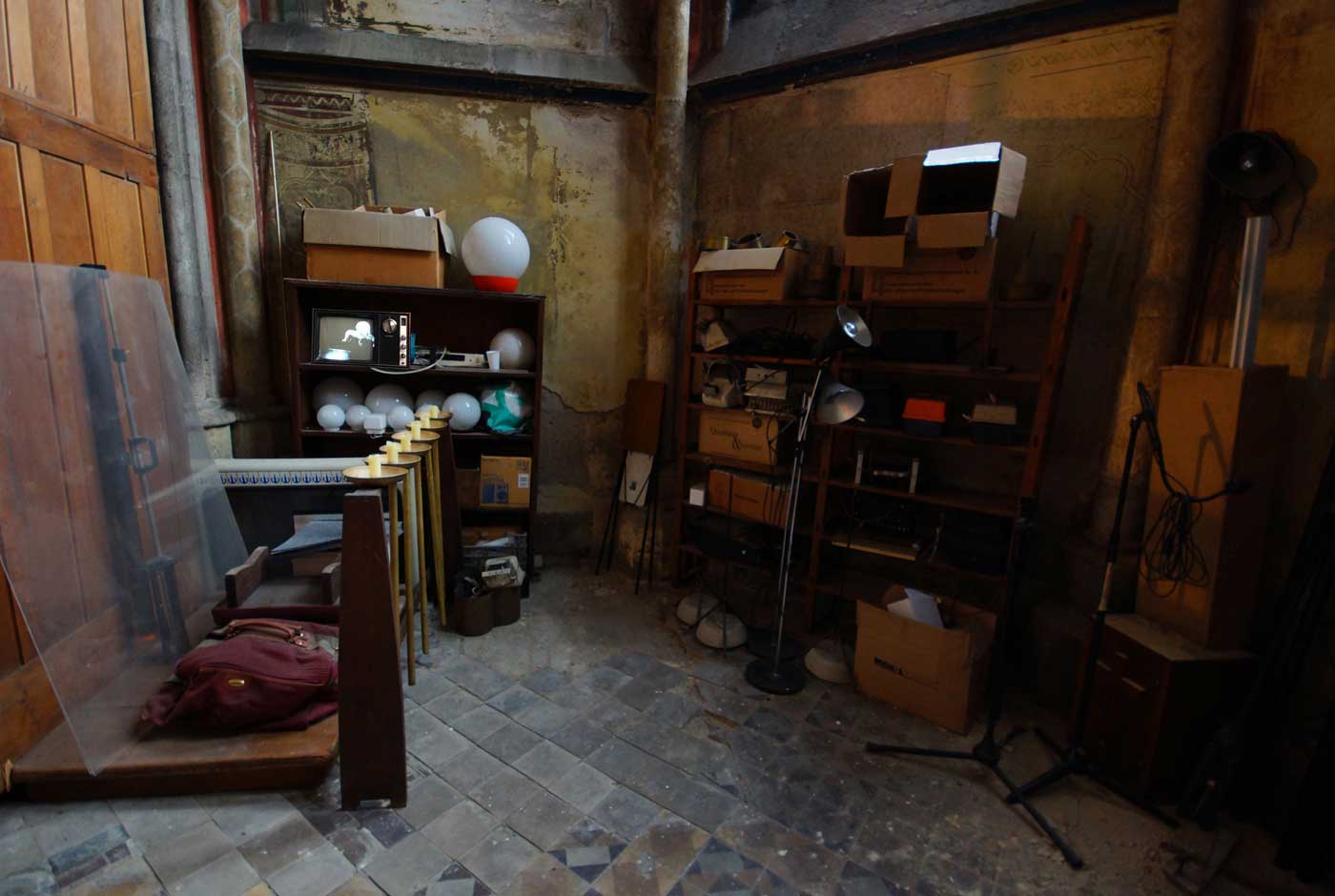
Hermann Glettler
Cleaning You
Leiblichkeit und Sexualität
Votive Church, Vienna, 2014
The subdivision of spaces within historic churches articulated the boundaries between private devotion and corporate ritual participation. Side altars, chapels and niches housed relics, tombs and devotional images which supported introspective contemplation, petition and the performance of private ritual. The presence of more than one altar dates back to the sixth century and the Lateran Basilica in Rome with its seven subsidiary altars, provides an early example of their presence in antiquity. In around 590, Bishop Palladius of Saintes erected twelve altars each dedicated to one of the apostles, in addition to the high altar. These altars were primarily used as depositories for offerings until the eighth century when they became predominantly repositories for relics. The rise of devotion to saints began in the ninth century and contributed to the widespread distribution of relics consisting mainly of dismembered parts of a saint’s corpse.9 The practice of trade guilds and devotional confraternities offering endowments for the construction of chantry chapels emerged in the twelfth and thirteenth centuries.10 These endowments coincided with an institutional reinforcement of a burgeoning devotionalism to individual saints and the Virgin.11 The funding of chapels by confraternities and families was often a religious expression of social status.12 In large monasteries, side altars along the nave of longitudinal ritual-architecture would be used simultaneously by individual monks for the Eucharistic ritual.13 These altars could also be used for smaller congregations. In the thirteenth century, where there were multiple priests in a monastery or Cathedral, numerous altars were required for each individual priest to independently perform the liturgical ritual.14 In 2006, Claudia Terstappen’s video work ‘Fire, Water, Sky & Earth’ was installed on the decommissioned St Brigid altar in St Patrick’s Cathedral in Melbourne. This particular work along with a number of others in the Crisis, Catharsis and Contemplation exhibition were seen as an offense to religious sensibilities. The very premise of introducing contemporary art into ritual space can arouse hostility from individuals for whom the historical building represents an idealised past. The problem with Terstappen’s work was mainly due to the medium of a moving image and the unexpected encounter of a television on an altar.
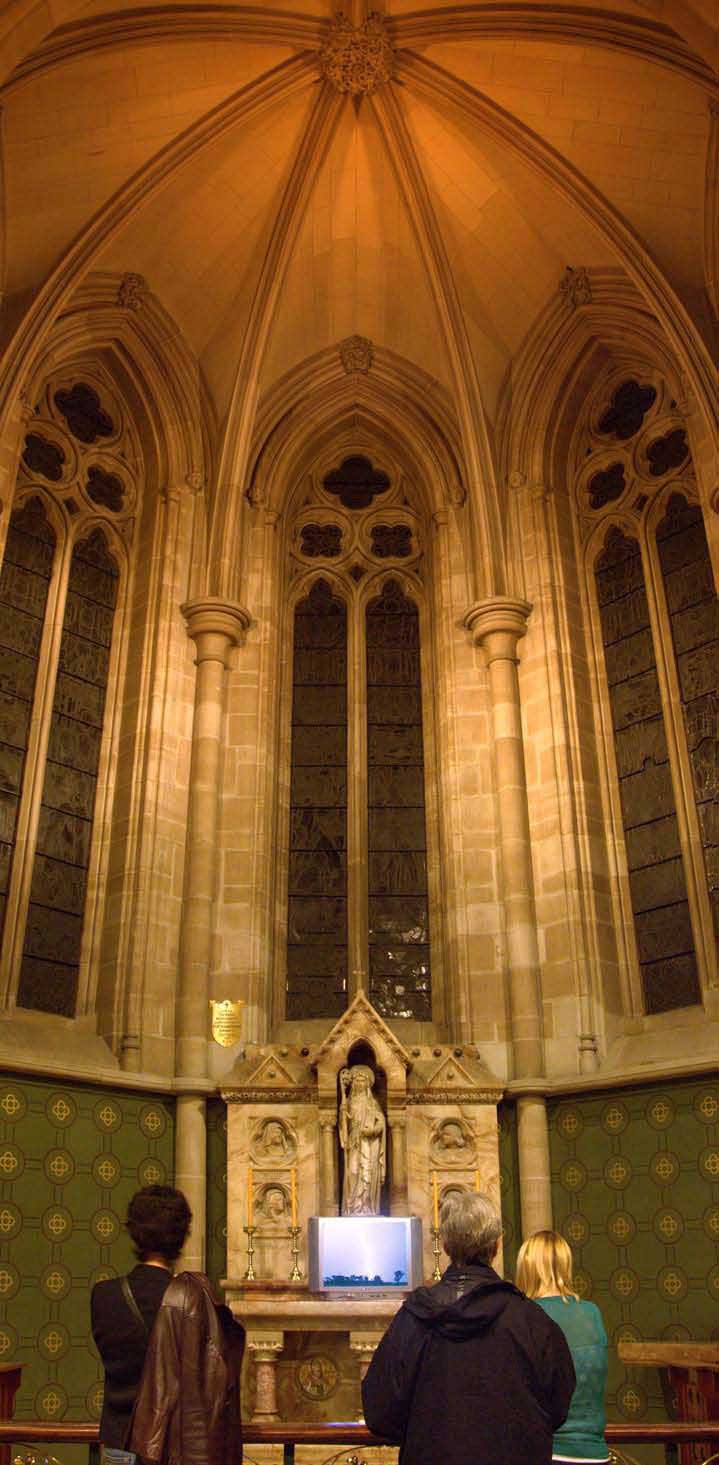
Claudia Terstappen
Fire, Water, Sky & Earth
Crisis, Catharsis & Contemplation
St Patrick's Cathedral, Melbourne, 2006
Because of their spatial structure, the enclosed space offers the individual an opportunity to shut out the rest of the building and concentrate on the artwork. The multiplication of subsidiary spaces incorporated into the main volume of the church during the Middle Ages, had their origin in the martyria. The martyrium were small mausoleums of porticoed apses extending off the courtyard of early Christian buildings. Until the fourth century, the primary ritual performed at the grave involved prayers for the repose of the soul of the martyr or saint. An altar was either raised over the tomb of a martyr or had relics placed within it during its consecration.15 Graves and tombs continued to be incorporated into ritual spaces into the nineteenth century and were often placed within designated funereal chapels for deceased, prominent members of the community. In 1879, the sixteenth century tomb of Count Niklas Graf von Salm was moved from the Dorotheer church in Vienna and installed in the Bishop’s chapel of the Votive Church. It was again moved in 1986 to its current location in the Rosary Chapel. As a site-responsive intervention in 2014, Javier Pérez’s ‘Memento Mori (Rosario)’ was installed in the chapel surrounding the tomb. His work included a series of fifty-nine life-size bronze skulls chained together in the form of a rosary. The relationship between Pérez’s installation and the Salm Grave gave the viewer an entry point into contemplating their own mortality. The sixteenth century grave on its own does little to speak of death, overshadowed by its presence as a monument to an influential historical figure.
,_2008-9,_Leiblichkeit_&_Sexualitat,_2014.jpg)
Javier Pérez
Memento Mori (Rosario)
Leiblichkeit und Sexualität
Votive Church, Vienna, 2014
Photo: Christoph Bartylla 2014
The presence of multiple altars in ritual architecture was also influenced by an attempt to imitate the landscape of Rome with its many churches.16 Each chapel could represent a remote location and allow visitors to journey through a series of proxy pilgrimage sites in a ritual procession. The path followed during the pilgrimage procession, involves a transition from the private space of devotion to the public space of liturgy. For the purposes of pilgrimage, the fluid transitions between distinct but integrated spaces, facilitate movement along individual paths. The transition from darkness to light, from narrow enclosures to open space and the contrast of movement and stillness are essential characteristics of historical forms of ritual architecture. An emphasis on transitions was important to Rudolph Otto, who found the ‘numinous’ in the contrast between qualities such as darkness, stillness, silence, and their opposites.17 The twenty-two artworks included in the Leiblichkeit und Sexualität exhibition were arranged along the path of a pilgrimage through the church. The first work that visitors encountered upon entering the church was Doug Aitken’s ‘No History.’ The work was constructed of hundreds of small, automated mirrors to form a kaleidoscopic experience that reflected both the viewer and the space in a state of change, flux and motion. Through obstructing direct access to the nave, the installation directed visitors to enter and “see one’s own image in amplified motion” before proceeding into the body of the church.
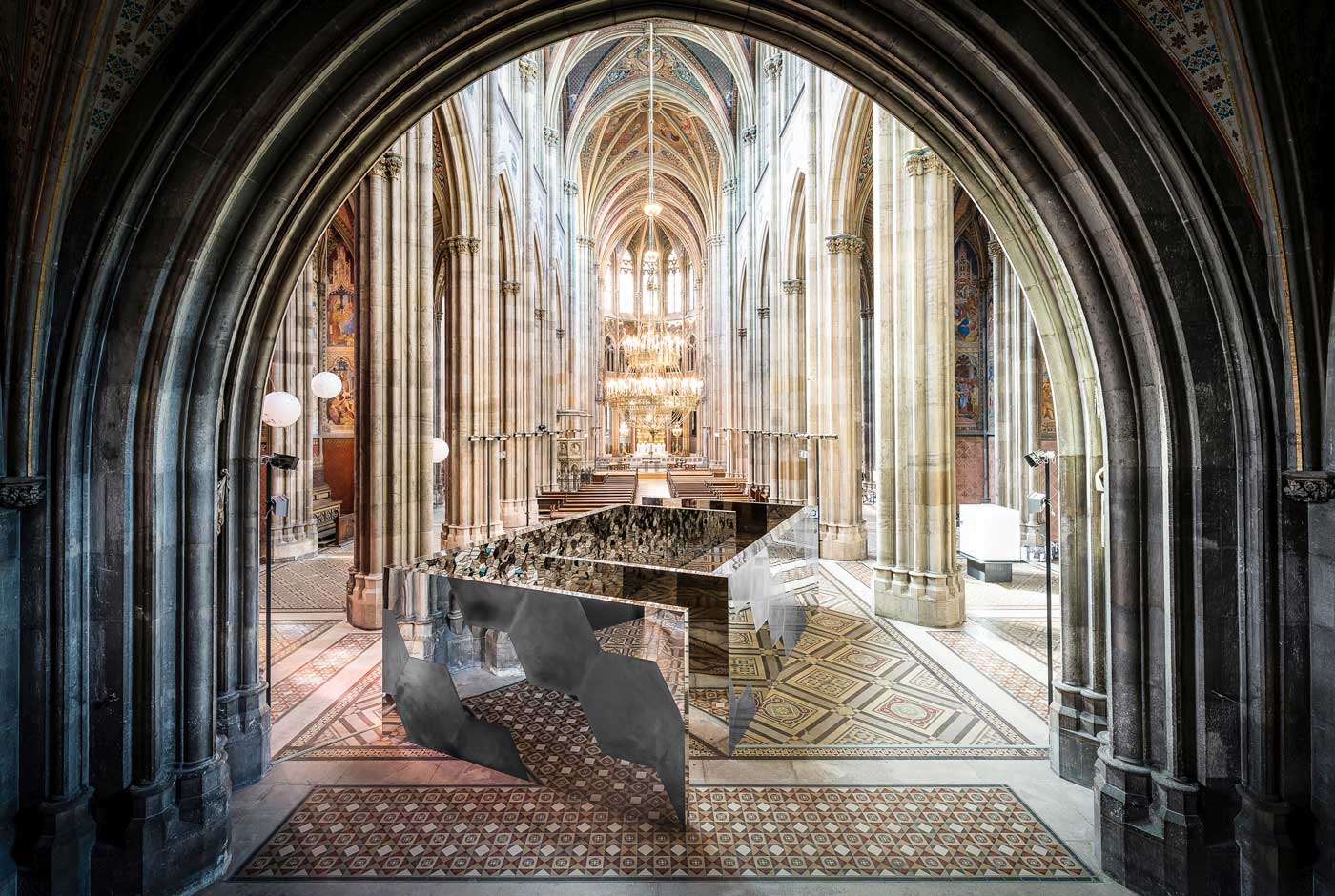
Doug Aitken
No History
Leiblichkeit und Sexualität
Votive Church, Vienna, 2014
Photo: Christoph Bartylla 2014
During the Middle Ages, the nave of a church functioned as an all-purpose public space, providing shelter for travellers, public meetings, games, theatrical performances, legal proceedings, teaching, military defence, and distribution of relief for the poor.18 Ritual architecture framed the merging of everyday life with private and public religious practice. The eventual reservation of ritual space for purely sacred functions began during the reformation. In the sixteenth century, the sacred function was formally sanctioned with the incorporation and central positioning of the tabernacle on an altar.19 The presence of the tabernacle, containing the transubstantiated species, prohibited activity which would be considered sacrilegious. Although the church building remains primarily the site for liturgical ritual, it functions today as a destination for pilgrimage, sanctuary for private contemplation, tourist attraction and occasionally even appropriates methods for the display of historical objects from museum practice. Religious space is rarely used for explicit political purposes, which made the events which took place in the winter of 2012/13 in the Votive Church an exception. A protest camp had occupied the Sigmund Freud Park, directly in front of the church for several months until it was dispersed by local law enforcement. Upon the arrival of the police, forty-seven asylum seekers stormed the Church and sought refuge in the lower southern side aisle for three months. The church authorities publicly announced their decision to allow the asylum-seekers to remain in the church with the Cardinal mobilising local charities to assist in taking care of their well-being. The asylum seekers slept in the unheated church while enduring a hunger strike which lasted eight weeks before they accepted the Cardinal’s offer for accommodation in a nearby monastery. For the period of their stay, the church functioned as both sanctuary and site for protest. A year later, the Leiblichkeit und Sexualität exhibition addressed the appropriation of ritual space for public protest through the intervention of an artwork in the location where the action took place. Karmen Frankl was approached with the proposal to install her work ‘Fliegenglobalisierung’ in the lower southern side aisle in response to the church functioning as sanctuary. Her work featured hand drawn maps of the world on six large white globes suspended by taut cables, fastened between the pillars. Each land mass was covered with glue mixed with sexual pheromones attractive to houseflies before the globes were hung outside to gather insects in public areas around Graz during the summer of 2013. The installation not only memorialised the protest by marking the space where the asylum seekers slept, but also contributed to public discussion on immigration politics. For many visitors to the exhibition, the crippled bodies of insects attached to the globes not only alluded to the migrant crisis and drew empathy for the disenfranchised but represented a “dialectic between internal identification and external ascription.”20
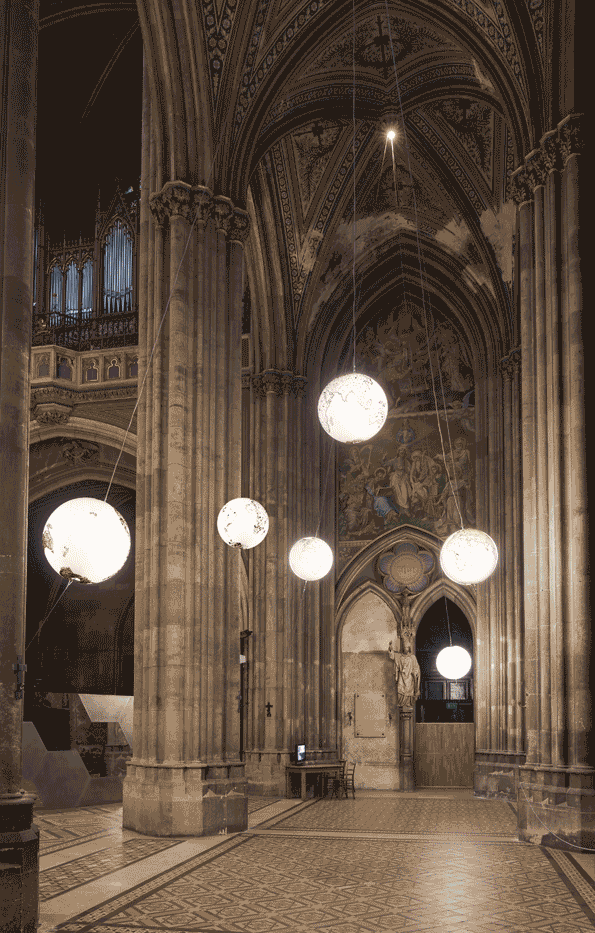
Karmen Frankl
Fliegenglobalisierung
Leiblichkeit und Sexualität
Votive Church, Vienna, 2014
Photo: Christoph Bartylla 2014
Ritual architecture represents the social, cultural and political forces that have historically bound the components of the religious institution. The socio-political history of ritual architecture has been shaped by the political role played by the monotheistic religious institution through its assertion as moral authority and instrument of justice. The contemporary artwork’s relationship with the social history of ritual space can question the involvement of religion in politics. An example of such an intervention was Barbara Kruger’s 2003 installation ‘Untitled (your devotion has the look of a lunatic sport)’ in Sankt-Peter Kunst-station in Cologne. Underneath a black and white photograph of hands clasped in prayer, Kruger’s iconic style of bold white text on red background read, ‘Who salutes the longest? Who prays the loudest? Who dies first? Who laughs last?’ drawing attention to the role of religion in world politics and its contribution to the rhetoric of patriotism.
The space of ritual architecture has the transparency of a vast and comprehensive ideology. Its nature is to point toward transcendence and to appeal to an external truth. The “abstract will to universality and the illusion thereof” are at the ideological foundation of ritual space.21 Nineteenth century historicist church architecture is the epitome of ideological space. The quest for symbolic resonance in historicist architecture projects a romanticised past into the present. The religious institution’s justification for the historicist ideal was a resistance to the idea of the human spirit being reconciled with the sensuous world; the spirit seeks to reconcile with itself, rather than with the external world. The philosophies and ideologies underpinning the emergence of a particular architectural style are inadvertently stripped from the historicist revival. In the case of the Votive Church, the urge to revive the past in architecture was an essentially bourgeois pursuit driven by a desire for a display of imperial wealth and power. The church was originally planned as a National Cathedral financed by Archduke Ferdinand Maximilian in thanksgiving for the survival of his brother, Emperor Franz Josef, after an assassination attempt. A clash of social realities takes place when contemporary art is positioned within such an aspirational space. For Bourriaud, the contemporary artwork does not attempt to represent ‘imaginary and utopian realities,’ but exists within the real.22 For art to be contemporary, it must exist spatially and temporally in the present cultural and social context. The presence of contemporary art in historical spaces draws attention to the immediacy of present experience. The reality that contemporary art forces us to confront in historicist space was a feature of Matthew Lenkiewicz’s ‘Erd Apfel’ installed in one of the ambulatory chapels of the Votive Church. In Lenkiewicz’s work, architecture acts as a mediator between myth and reality. Erd Apfel referenced the work of Neo-Futurist Architect Buckminster Fuller, whose experiments with Icosahedron globes and other geodesic forms elaborate an idealistic vision of the future that include efficiency, lightness and technological harmony. The ambulatory chapel’s trefoils and quatrefoils symbolize a wholly different ideological view of the cosmos where Earth’s inhabitants are at the centre of an illusory construct, in which our true orientation is only made apparent through an understanding of the Trinity or through the teachings of the four evangelists. The work drew together a Christian theological world view, as represented in the quatrefoil and trefoil forms of the neo-gothic window, with the rationalist, democratic, capitalist cosmology of Buckminster Fuller’s dymaxion globe. These two utopian ideologies were combined to question the objectivity of the viewer and to examine their worldview through a contemporary lens. The work took a sensorial and phenomenological approach to interrogate the tension caused by an embedded reinterpretation of the historic space.
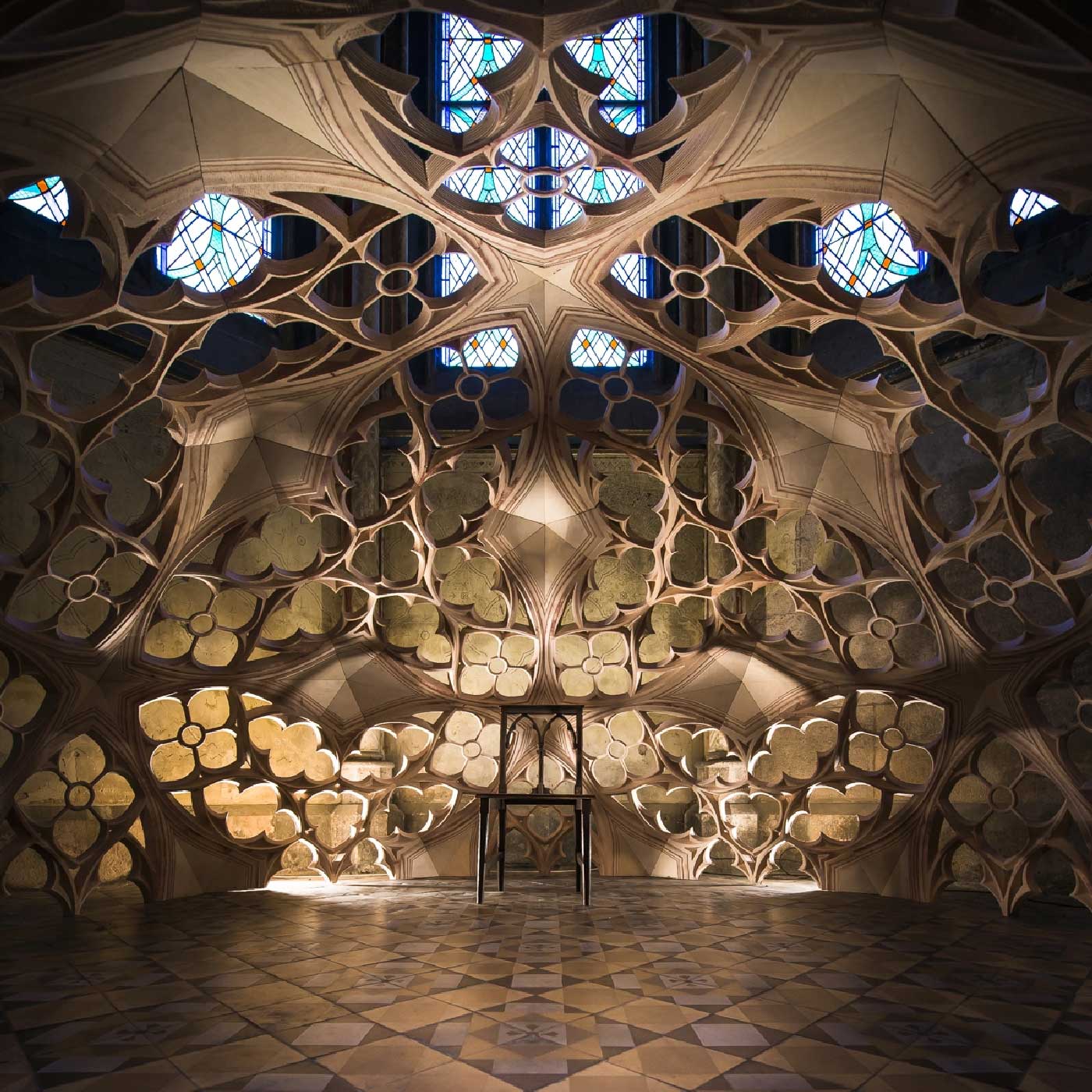
Matthew Lenkiewicz
Erd Apfel
Leiblichkeit und Sexualität
Votive Church, Vienna, 2014
Photo: Christoph Bartylla 2014
One of the effects of the Enlightenment was the withdrawal of religion into the private sphere. As religion became a matter of private choice, there was a shift toward syncretic, private forms of belief where transcendental experience was sought outside of the religious institution and ritual space. For Luckmann, the gallery provided more relevant articulated systems of subjective significance for the individual.23 Major changes in ritual space and modern art took place almost concurrently in the 1960s. The religious institution increasingly commissioned the construction of aesthetically neutral spaces while the experience of modern art became increasingly tied to the emergence and prominence of neutralised exhibition spaces. Both exhibition spaces and ritual spaces were taking a turn toward isolating the primary object from its surroundings. As the white cube was becoming an established convention for the enshrining of modern art, ritual spaces introduced the practice of removing all decoration and whitewashing walls. Influenced by the Arts and Crafts Movement, some notable examples of the stripping down of ritual spaces include the Chapel at Burg Rothenfels am Main, Cathedral of St Frances de Sales in Oakland, California, and Sankt Peter’s in Cologne. The work of art, removed from the white cube and placed in ritual space becomes re-contextualised, appropriated and cannot be thought of any longer as an isolated, independent or autonomous object. The hybrid space between the artwork and ritual architecture, between the art object and other objects encountered in the same environment, becomes the locus of meaning. The irreducibility of the object from the enveloping space it inhabits opens a ‘third space’ between the object-in-space and the viewer. The forging of this space reorients attention toward the immateriality of the art experience and becomes the primary medium of the artwork. Where emphasis is placed on formal properties when art is presented as autonomous, the third space between object, place of encounter and recipient virtually vaporises notions of a concrete medium to make way for the medium to be considered as the subjective encounter of trans-actual assemblages in space.
While an academic interpretation of the historical site might privilege the retrieval of perceptions held by the original addressees, the intervention of contemporary art in the space disrupts this privileging and forces the interpretation to negotiate the significance of the space for the visitor today. The presence of contemporary art releases the historical site from hermeneutic interpretation and gives it a relevance for today that allows for a matrix of subjective orientations. The site can be read, decoded and analysed in the same way that a text is interpreted and “structured (inter)textually rather than spatially.”24 Rather than meaning being universal and static, cartographies of inter-subjectivity allow multiple meanings that can be drawn from the art experience. Something like a suspended attention, a prolonged suspension of the moment of reaching conclusions, where interpretation would have time to deploy itself in several dimensions, between the grasped visible and the lived ordeal of a relinquishment. Linguists Gilles Fauconnier and Mark Turner developed a theory called ‘conceptual blending’ to describe the subconscious process of integrating a network of diverse elements and relations into mental space. This theory provides a useful approach to consider the cognitive implications of encountering contemporary art in ritual architecture. According to Fauconnier and Turner, the process of conceptual blending involves the projection of two distinct input spaces and their vital relations into a blended mental space.25 In the encounter of contemporary art in ritual space, the artwork and the site are two distinct inputs. The first input is the art event and the second input is the ritual-architectural event. The two events share the schematic frame of the exhibition, which connects them and is referred to as a “generic space.” Conceptual blending consists in ‘partially matching the two inputs and projecting selectively from these two input spaces into a fourth mental space, the blended space.’26 The installation of Suzie Léger’s {Uterus = Space = Universe} in St Peter and Paul’s Church in Vienna provides an opportunity to demonstrate an application of conceptual blending. The multiplicity of potential meanings arising from an encounter with the artwork in the tabernacle form a conceptual integration network consisting offour connected mental spaces. The artwork was one of five works installed in the ‘generic space’ of the INNENraum exhibition in 2015. The first input space was the video installation featuring an ultrasound of an empty uterus overlaid with footage from the Hubble space telescope. The second input space was the fourteenth century chapel featuring an altar, tabernacle and a version of the Austrian pilgrimage statue of Mariazell. The blended space consisted of symbolic associations of the womb shared by the tabernacle, statue and ultrasound. In Catholic tradition, the Virgin Mary is referred to as the ‘first tabernacle’27 and even the visitor unfamiliar with this information is still confronted with the ultrasound and a statue depicting a pregnant woman. The blended space is ‘constructed through selective projection from the inputs, pattern completion, and dynamic elaboration.’28 The selective projection of the concept of the womb was derived from both the artwork and the ritual space. The activation of ‘structures available from long-term memory’ assisted in the pattern completion.29 This type of conceptual integration network would be referred to as a ‘Simplex’30 by Fauconnier and Turner, where the tabernacle is the frame and the video is a specific element within that frame.
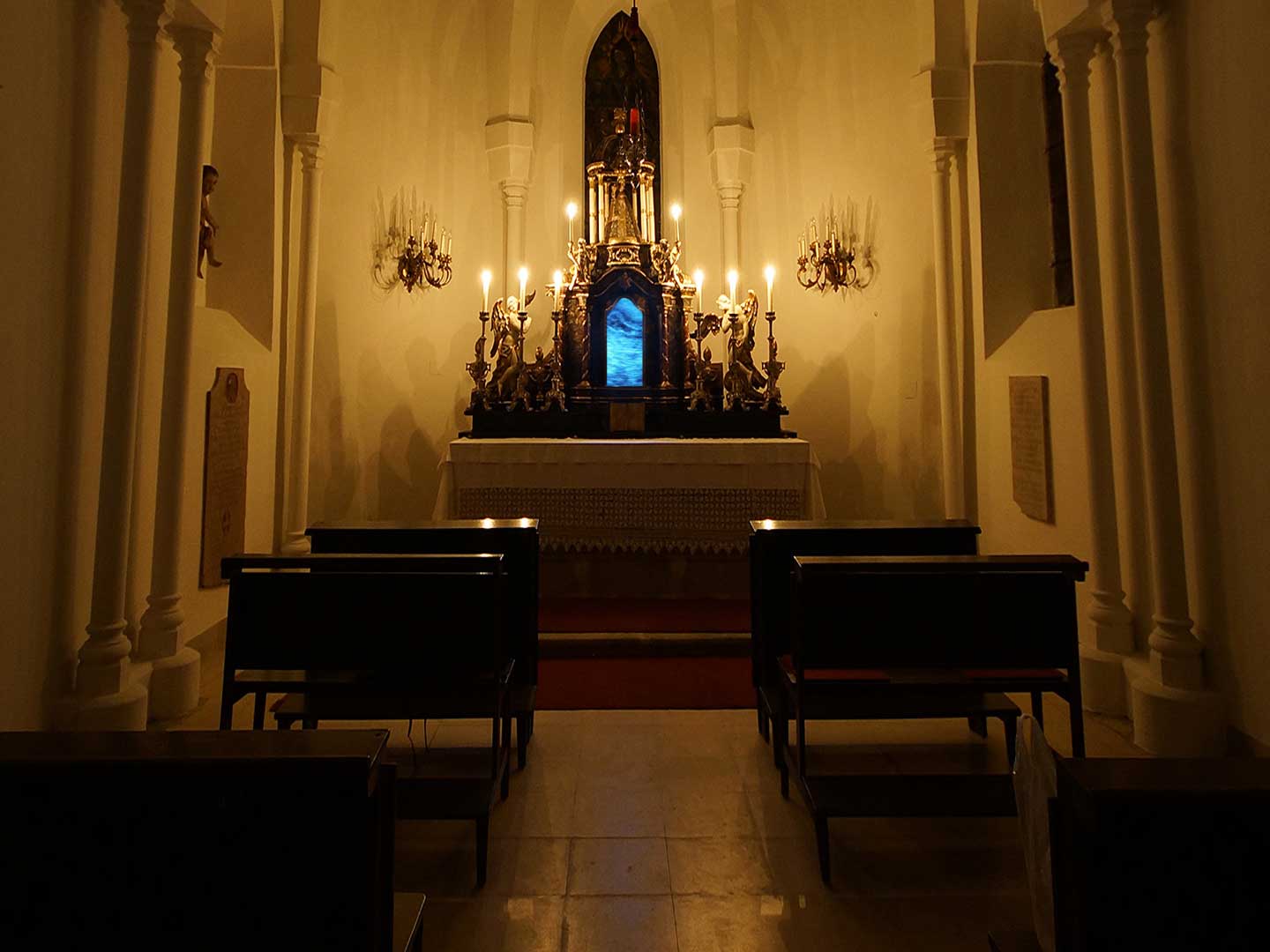
Suzie Léger
{Uterus = Space = Universe}
INNENraum
St Peter and Paul's Church, Vienna, 2015
A particular sensitivity to the primary function of the space is required when commissioning artworks and installing works from public and private collections. Aside from obvious issues arising from an artwork’s potential to interfere with the ritual function of religious space, cynicism or disruption in the relationship between the work, site, and its public, can cause hostility and offense. The responsibilities of the curator in commissioning contemporary art include taking measures to ensure against the inclusion of works which appear indifferent to the particular conditions of the site. The success of a commissioned work is dependent on its capacity to be integrated into the architectural fabric of the building and the freedom extended to the artist to work with forms and ideas that fall far outside the visual imaginary of a tradition that makes demands for the familiar. The curator should endeavour to select works whose content reflects specifically upon the institutional, discursive and social relationships inherent to the site and whose form appears to be shaped by its spatial environment.
1 Kwon, Miwon. One Place After Another: Notes on Site Specificity. October, Vol. 80 (Spring 1997) p. 95
2 Gaiger, Jason. Dismantling the Frame: Site-Specific Art and Aesthetic Autonomy. British Journal of Aesthetics, Vol. 49 No. 1 (January 2009) p. 49
3 Foucault, Michel. The History of Sexuality Volume 1: An Introduction. New York: Vintage Books, 1978. p. 18
4 Nelson, Robert. The Spirit of Secular Art: A History of the Sacramental Roots of Contemporary Artistic Values. Melbourne: Monash University Press, 2007. p. 8
5 Jones, Lindsay. The Hermeneutics of Sacred Architecture: Experience, Interpretation, Comparison. Volume Two | A Morphology of Ritual-Architectural Priorities. Harvard University Press: Cambridge MA, 2000. p. 38
6 ibid. p. 46
7 Kroegel, Alessandra Galizzi. '"The Museum of Contemplation" or Kolumba. The Art Museum of the Archbishopic of Cologne' in Minuccciani, Valeria (ed.) Religion and Museums: Immaterial and Material Heritage. Torino: Umberto Allemandi & C., 2013. p. 80
8 Stegers, Rudolf. Sacred Buildings: A Design Manual. Basel: Birkhäuser, 2010. p. 9
9 Crook, John. The Architectural Setting of the Cults of Saints in the Early Christian West, c. 300–1200. Oxford: Clarendon, 2000
10 Fernie, Eric and Crossley, Paul (eds.), Medieval Architecture and Its Intellectual Context. London: Hambledon, 1990. pp. 137–42
11 Kieckhefer, Richard. “Major Currents in Late Medieval Devotion,” in Jill Raitt, (ed.), Christian Spirituality, vol. 2. New York: Crossroad, 1987. pp. 75–108
12 ibid. p. 36
13 ibid. p. 35
14 ibid. p. 80
15 Döllinger, Johann Joseph Ignaz von. A History of the Church. Vol II. (trans. Edward Cox) New York: C. Dolman, 1841. p.351
16 de Blaauw, Sible. “Architecture and Liturgy in late Antiquity and the Middle Ages,” Archiv für Liturgiewissenschaft 33, 1991. p. 21–22.
17 Otto, Rudolf. The Idea of the Holy, trans. John W. Harvey, 2nd ed. London: Oxford University Press, 1950. p. 68
18 Jung, Jacqueline. “Beyond the Barrier: The Unifying Role of the Choir Screen in Gothic Churches,” Art Bulletin 82., 2000. p. 629
19 Kieckhefer, Richard. (2004) p. 78
20 Howard, J. A. Social Pyschology of Identities. Annual Review of Sociology. Vol. 26. (2000) p. 375
21 Debord, Guy. The Society of the Spectacle. New York: Zone Books, 1994. part. 213
22 Bourriaud, Nicolas. Relational Aesthetics. Paris: Les Presses du reel, 2002. p. 13
23 Luckmann, Thomas. The Invisible Religion: The Problem of Religion in Modern Society. New York: Macmillann. 1967. p. 91
24 Kwon, Miwon. One Place After Another: Site-Specific Art and Locational Identity. Cambridge, Massachusetts: The MIT Press, 2003. p. 29
25 Fauconnier, Gilles and Turner, Mark. Conceptual Blending, Form and Meaning. Recherches en communication, no 19 (2003) p. 57
26 Ibid. pp. 58-59
27 Bonaventure. Sermo IV de Annunciatione. [IX, 672 b] cf. St. Bonaventure, Legenda Maior, c. 9, 3. “…In hoc sacrum tabernaculum, id est sacrosanctum uterum…” (Into this sacred tabernacle, i.e., her sacrosanct womb.)
28 Fauconnier and Turner. (2003) p. 60
29 Ibid. p. 60
30 ibid. (2003) p. 61
Suggested citation:
Rastas, David. Problems integrating Contemporary Art into Ritual Spaces. Helsinki: Otherspaces, 2018. Retrieved from http://www.otherspaces.org/ritualspaces.html